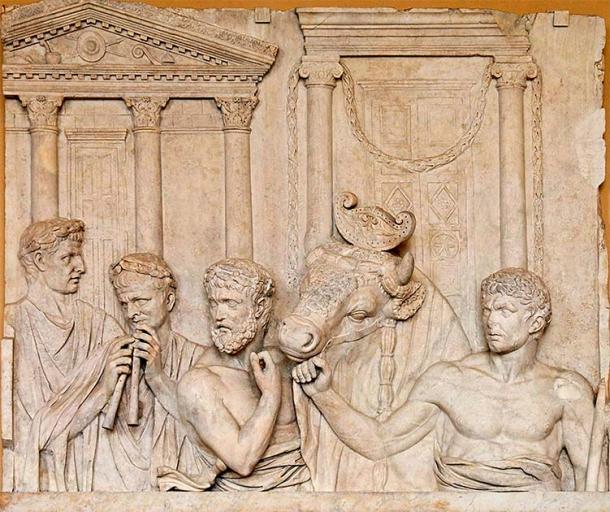Dies Sanguinis: Rome's Day of Blood, Sacrifice & Military Might
Dies Sanguinis, meaning “Day of Blood” or “Day of the Bloody Sacrifice,” was an intense, yet sacred, day in the Roman calendar. Celebrated annually on March 24th, this day was dedicated to the goddess Bellona, who was known for her association with war, bloodshed and violence.
Those celebrating this sacred day typically engaged in animal sacrifices, including the sacrifice of a bull, performed by Roman priests in the Temple of Bellona. But what was the purpose behind such gruesome rituals?

Animal sacrifice was an important aspect of many Roman ceremonies, especially for the Dies Sanguinis. (Fair use)
The Mysterious Origins of Dies Sanguinis: Rome's Oldest Festival
The exact origins of Dies Sanguinis are not entirely clear, as there are few surviving historical records or accounts of the early practices associated with the day. However, it is believed to have been one of the oldest and most significant festivals in the Roman calendar, dating back to the early days of the Roman Republic.
- Bellona: The Roman Goddess of War and Artistic Muse
- The Ides of March, Celebration of Roman Goddess Anna Perenna
One theory about the origins of Dies Sanguinis is that it may have been associated with ancient Roman agricultural practices. March 24th was considered the first day of the agricultural year in ancient Rome, and it was believed to be a favorable time to start spring plowing and planting. As such, it is possible that the sacrifices and rituals performed on this day were intended to appease the Roman gods and ensure a successful growing season.
What researchers do know is that the origins of Dies Sanguinis are connected to the early Roman military. Bellona, the goddess of war who was honored on this day, was believed to have been a central figure in the Roman army and may have been invoked to ensure military success and victory in battle. By providing her with the blood of sacrificial animals, Romans would have believed that she would guarantee the blood of their enemies.
It is also possible that the day of Dies Sanguinis was simply a way for the Roman state to demonstrate its commitment to military power and aggression, as well as to reinforce the idea of Rome as a warrior nation.

Reconstruction of the Temple of Bellona in Rome (on the right), next to the Temple of Apollo Sosianus (center) and the Theatre of Marcellus (left). The Dies Sanguinis, or Day of Bloody Sacrifice, was dedicated to the goddess Bellona. (Larry Koester / CC BY 2.0)
The Significance of Blood Sacrifice and National Identity in Dies Sanguinis
Dies Sanguinis was a festival of great significance for the Roman military. This sacred day was typically used to honor the Roman army and demonstrate the commitment of the Roman people to victory in war. It was also a noteworthy day for military recruitment and the swearing of oaths of loyalty to the state.
Animal sacrifices, including the main sacrifice of a bull, were performed in the Temple of Bellona during Dies Sanguinis. Dedicated to Bellona, the temple is believed to have been built to commemorate a Roman military victory over the Sabines. The blood of the sacrificed animals was used in various religious rituals and ceremonies held throughout the day, all of which held different levels of importance.
Dies Sanguinis was also characterized by a combination of religious and military processions, such as the appearance of the Salii, a group of twelve priests who carried sacred shields and performed warlike dances to honor Bellona and demonstrate the military strength of Rome. These performances were an essential aspect of many of the smaller rituals that occurred during the long day of bloodshed.

Marble relief from 2nd century Rome depicting preparations for an animal sacrifice. (Public domain)
The Rise of Christianity and the Fall of Dies Sanguinis
As time passed, celebrations of Dies Sanguinis became more and more infrequent. This decline can be attributed to several factors, such as the growing influence of Christianity in the Roman Empire and the changing values and beliefs of the ancient Romans.
The influence of philosophy and religion played a major role in the shift toward peace in ancient Rome. Philosophers like Seneca and Epictetus emphasized the importance of inner peace and moral righteousness over military conquest and power, which made a great impact on their followers.
Similarly, the spread of Christianity in the Roman Empire promoted values of love, compassion and forgiveness, which were at odds with the militaristic and violent tendencies of Roman culture. As Christianity gained prominence in the Roman Empire, many of the traditional Roman religious practices and beliefs began to be viewed as pagan and incompatible with Christian doctrine.
- Who is Bellona and Was She More Powerful than Mars? Piecing Together the Identity of the Mysterious Ancient Roman Goddess of War
- The Busy Romans Needed a Mid-Winter Break Too … and it Lasted for 24 days
Soon, the values and beliefs of the Romans shifted away from the militaristic and warlike tendencies that had been so central to the celebration of Dies Sanguinis. As the empire grew more stable and secure, they placed more value on peace and prosperity than on military conquest.
Plus, the Romans realized that they could enjoy the benefits of a thriving economy and a stable government without needing to rely on military conquest to sustain their way of life. This led to the gradual decline and eventual suppression of many traditional Roman religious festivals and practices, including Dies Sanguinis.
The final cause behind the disappearance of Dies Sanguinis was the decline of the Roman Empire itself. As Rome's power waned and the empire fell into decline, many of the traditional practices and beliefs associated with the festival were forgotten or abandoned.
Invasions and migrations of Germanic tribes from the north and east gradually carved out new kingdoms and territories within the former Roman Empire and, as a result, the Roman way of life and culture (including Dies Sanguinis) gradually gave way to new forms of governance, religion and social organization.
Dies Sanguinis once held great cultural and religious significance in ancient Rome and was celebrated as a time to honor the military and demonstrate their martial strength. Though it eventually fell to the sands of time, the bloodthirsty legacy of Dies Sanguinis lives on for researchers worldwide, as it provides insight into the complex and multifaceted nature of ancient Roman culture and society.
Top image: Dies Sanguinis, meaning “Day of Blood,” was a Roman celebration dedicated to the goddess Bellona, associated with war, bloodshed and violence. Source: Михаил Решетников / Adobe Stock
By Lex Leigh
References
Alchin, L. No date. “Bellona” in Roman and Greek Gods. Available at: https://www.talesbeyondbelief.com/roman-gods/bellona.htm
Meyer, M. 1999. The ancient mysteries: A sourcebook of sacred texts. University of Pennsylvania Press.
Pachis, P. 2020. “Rites of the day of blood (dies sanguinis) in the Graeco-roman cult of Cybele and Attis” in Journal of Cognitive Historiography, 5(1-2), 37–55. Available at: https://doi.org/10.1558/jch.39915
Pearse, R. 26 March 2011. “Dies sanguinis – what do we know about this?” in Roger Pearse. Available at: https://www.roger-pearse.com/weblog/2011/03/26/dies-sanguinis-what-do-we-know-about-this/
Poplacean, D. M. 2017. “The Business of Butchery: Bellona and War, Society and Religion from Republic to Empire” in McGill University (Masters Thesis). Available at: https://www.academia.edu/34908118/The_Business_of_Butchery_Bellona_and_War_Society_and_Religion_from_Republic_to_Empire

















